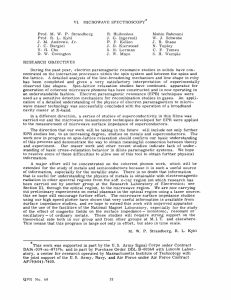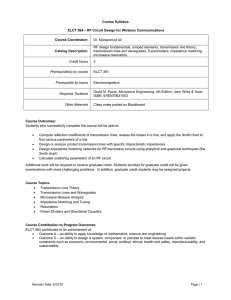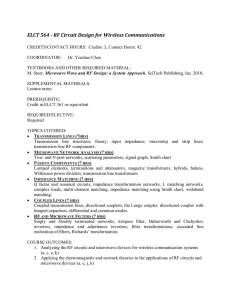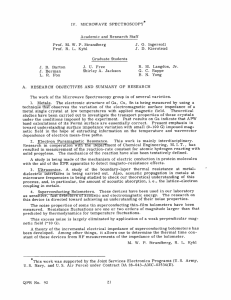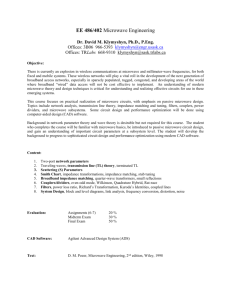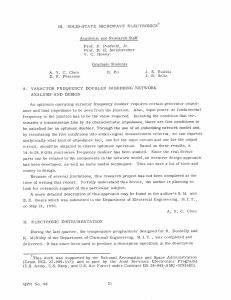Report - IEEE Microwave Theory and Techniques Society
advertisement
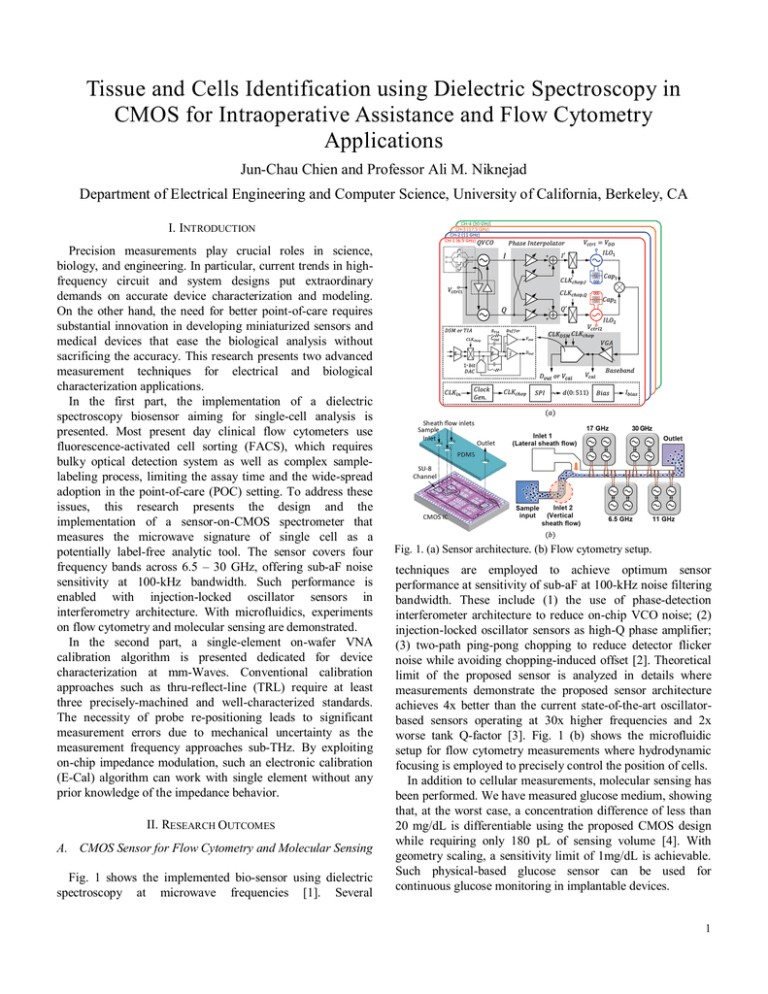
Tissue and Cells Identification using Dielectric Spectroscopy in CMOS for Intraoperative Assistance and Flow Cytometry Applications Jun-Chau Chien and Professor Ali M. Niknejad Department of Electrical Engineering and Computer Science, University of California, Berkeley, CA I. INTRODUCTION Precision measurements play crucial roles in science, biology, and engineering. In particular, current trends in highfrequency circuit and system designs put extraordinary demands on accurate device characterization and modeling. On the other hand, the need for better point-of-care requires substantial innovation in developing miniaturized sensors and medical devices that ease the biological analysis without sacrificing the accuracy. This research presents two advanced measurement techniques for electrical and biological characterization applications. In the first part, the implementation of a dielectric spectroscopy biosensor aiming for single-cell analysis is presented. Most present day clinical flow cytometers use fluorescence-activated cell sorting (FACS), which requires bulky optical detection system as well as complex samplelabeling process, limiting the assay time and the wide-spread adoption in the point-of-care (POC) setting. To address these issues, this research presents the design and the implementation of a sensor-on-CMOS spectrometer that measures the microwave signature of single cell as a potentially label-free analytic tool. The sensor covers four frequency bands across 6.5 – 30 GHz, offering sub-aF noise sensitivity at 100-kHz bandwidth. Such performance is enabled with injection-locked oscillator sensors in interferometry architecture. With microfluidics, experiments on flow cytometry and molecular sensing are demonstrated. In the second part, a single-element on-wafer VNA calibration algorithm is presented dedicated for device characterization at mm-Waves. Conventional calibration approaches such as thru-reflect-line (TRL) require at least three precisely-machined and well-characterized standards. The necessity of probe re-positioning leads to significant measurement errors due to mechanical uncertainty as the measurement frequency approaches sub-THz. By exploiting on-chip impedance modulation, such an electronic calibration (E-Cal) algorithm can work with single element without any prior knowledge of the impedance behavior. II. RESEARCH OUTCOMES A. CMOS Sensor for Flow Cytometry and Molecular Sensing Fig. 1 shows the implemented bio-sensor using dielectric spectroscopy at microwave frequencies [1]. Several Fig. 1. (a) Sensor architecture. (b) Flow cytometry setup. techniques are employed to achieve optimum sensor performance at sensitivity of sub-aF at 100-kHz noise filtering bandwidth. These include (1) the use of phase-detection interferometer architecture to reduce on-chip VCO noise; (2) injection-locked oscillator sensors as high-Q phase amplifier; (3) two-path ping-pong chopping to reduce detector flicker noise while avoiding chopping-induced offset [2]. Theoretical limit of the proposed sensor is analyzed in details where measurements demonstrate the proposed sensor architecture achieves 4x better than the current state-of-the-art oscillatorbased sensors operating at 30x higher frequencies and 2x worse tank Q-factor [3]. Fig. 1 (b) shows the microfluidic setup for flow cytometry measurements where hydrodynamic focusing is employed to precisely control the position of cells. In addition to cellular measurements, molecular sensing has been performed. We have measured glucose medium, showing that, at the worst case, a concentration difference of less than 20 mg/dL is differentiable using the proposed CMOS design while requiring only 180 pL of sensing volume [4]. With geometry scaling, a sensitivity limit of 1mg/dL is achievable. Such physical-based glucose sensor can be used for continuous glucose monitoring in implantable devices. 1 To improve 1/f noise performance, a near-field modulation chopping technique is proposed [5]. The modulation is achieved by periodically shielding the fringing electric fields using another set of electrodes placed on top of the sensing ones. The shielding is enabled by switching on a NMOS transistor. The sensor improves the 1/f corner frequency from 10 to 0.25 kHz. Molecular sensing on bovine serum albumin (BSA) solution has been demonstrated. In the same project, a quadrature VCO design using passive coupler is explored [6]. For the first time, the importance of coupler non-linearity is identified. B. Single-element On-wafer De-embedding Technique Fig. 2 shows the concept for single-element de-embedding/ calibration technique using CMOS for on-wafer VNA measurements. The proposed technique measures only the Sparameter of a single structure, which comprises three NMOS transistors serving as impedance modulators and a transmission line (t-line) with known length but unknown propagation constant (γ). The impedance of each device is controlled through individual gate bias in an analog fashion. The end result is to solve for Sx which consists of three unknowns (e00, e11, and e01 = e10) without any prior knowledge of the actual impedance value. The proposed algorithm involves two techniques to distill four measurements that are beneficial for solution finding [7]. The first technique is termed quasi-extrapolation where reflection measurements with known termination can be extrapolated from the raw measurements with modulated impedance. The second step is to share and match the series impedance from both ports such that additional measurements can be derived without introducing additional unknown. Measurements verify that the proposed single-element approach can achieves correct solution when compared to TRL. Impedance can be further re-normalized using the channel resistance provided by the on-chip transistors measured at DC [8]. III. IMPACT OF MTT-S FELLOWSHIP AND FUTURE WORK I would like to acknowledge MTT-S for the support for both the research and attending the IMS conferences. During the conferences, I have attended workshops on microwave sensing for biomedical applications twice and was part of the interactive forum for the student paper finalists in IMS 2015. With such opportunity, I get chances to meet research fellows to exchange research experience, unsolved issues, and potential research directions. For example, I have met with Professor Arnaud Pothier and Dr. James Booth to learn the best way for microfluidic control in single cell experiments. I also received numerous feedbacks on the single-element calibration algorithm during the poster session in ARFTG 2015 including potential error sources, repeatability considerations, and different ways of impedance Fig. 2. (a) Single-element de-embedding concept. (b) Structure. renormalization. All these interaction are helpful in advancing the research. In the future, I would like to work in the academia, aiming to utilize the capability of CMOS for system-level design to solve healthcare problems. REFERENCES [1] J.-C. Chien, M. Anwar, E.-C. Yeh, L. P. Lee, and A. M. Niknejad, “A 6.5/17.5-GHz dual-channel interferometer-based capacitive sensor in 65-nm CMOS for high-speed flow cytometry,” International Microwave Symposium (IMS), Jun. 2014, pp. 1 – 4. [2] J.-C. Chien, M. Anwar, E.-C. Yeh, L. P. Lee, and A. M. Niknejad, “A 6.5/11/17.5/30-GHz high throughput interferometer-based reactance sensors using injection-locked oscillators and ping-pong nested chopping,” Digest of Symposium on VLSI Circuits (VLSIC), Jun. 2014, pp.132 – 133. [3] J.-C. Chien and A. M. Niknejad, “Oscillator-based reactance sensors with injection-locking for high-throughput flow cytometry using microwave dielectric spectroscopy,” submitted to IEEE Journal of Solid-State Circuits (JSSC). [4] J.-C Chien, E.-C. Yeh, M. Anwar, L. P. Lee, and A. M. Niknejad, “A microwave reconfigurable dielectric-based glucose sensor with 20 mg/dL sensitivity at sub-nL sensing volume in CMOS,” International Microwave Symposium (IMS), May. 2015, pp. 1 – 4. [5] J.-C. Chien and A. M. Niknejad, “A near-field modulation chopping stabilized injection-locked oscillator sensor for protein conformation detection at microwave frequency,” accepted to Symposium on VLSI Circuits, Jun. 2015. [6] N.-C. Kuo, J.-C. Chien, and A. M. Niknejad, “Design and analysis on bidirectionally and passively coupled QVCO with nonlinear coupler,” IEEE Transactions on Microwave Theory and Techniques (T-MTT), vol. 63, no. 4, pp. 1130 – 1141, Apr. 2015. [7] J.-C. Chien and A. M. Niknejad, “A single-element CMOSbased electronic de-embedding technique with TRL level of accuracy,” International Microwave Symposium (IMS), May. 2015, pp. 1 – 4. [8] J.-C. Chien and A. M. Niknejad, “Impedance renormalization in CMOS-based single-element electronic calibration,” ARFTG Microwave Measurement Conference, May 2015. 2
